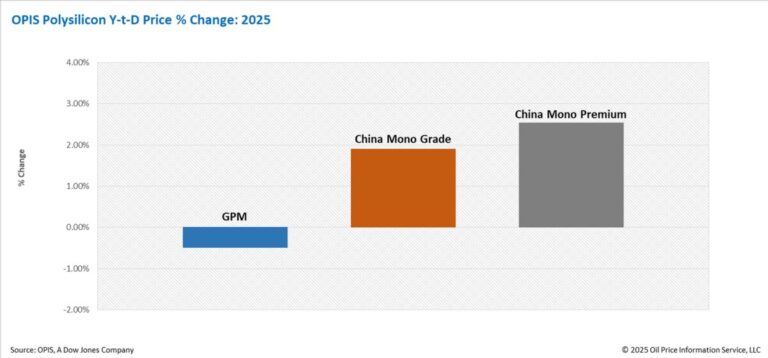In a new weekly update for PV -MagazineOpis, a Dow Jones company, offers a quick look at the most important trends in the global PV industry.
The Global Polysilicon Marker (GPM), the OPIS -Benchmark for Polysilicon produced outside China, was assessed this week at $ 20,260/kg, or $ 0.046/w. The global polysilicon market remains stable, without significant changes in buying and selling dynamics.
The average operational percentage of global polysilicon production is around 60%, with a total monthly output of around 6000 MT, according to market sources.
However, the turnover is mainly driven by three to four large wafer manufacturers, who remain willing to place monthly orders under long -term contracts. While the monthly consumption falls short of the total production, the stock levels at both the supplier and the buyers’ side increase. The market is also waiting for the expansion of the production capacity of non-Chinese wafer to diversify the customer base. In view of these conditions, sources indicate that a price increase for worldwide Polysilicon remains unlikely in the short term.
A market observer who analyzed trade flows that waffles made from worldwide polysilicon are mainly sold to Indonesia and Laos, where they are further processed into power -reducing products for export to the United States. In addition, a company in Cambodia, which launches 2 GW from Ingot -Production in May, has emerged as a potential new customer for global suppliers of Polysilicon, given the estimated annual demand for polysilicon of approximately 5,000 MT.
In the meantime, it is said that the planned polysilicon factory of 100,000 MT per year in Oman will start a partial production in May or June. Sources, however, indicate that further delays are possible, because from May the peak summer season could be challenges for energy-intensive production activities in the region.
The China Mono Grade, the assessment of Opis for Polysilicon prices of mono-quality in the country, remained stable this week on CNY 33.625 ($ 4.63)/kg, equal to CNY 0.076/W. Likewise, the China Mono Premium, the price assessment of OPIS for mono-grade polysilicon used for the N-type Ingot production, stable on CNY 40.375/KG, or CNY 0.091/W.
Despite an increase in domestic solar installations in China, powered by two new sun policy that come into force in May and June, Wafers manufacturers remain carefully in their polysilicon -purchasing, which limits the potential for the price increases of the polysilicon. This cautious approach is largely due to the approximately 200,000 MT Polysilicon that is currently being held in wafers inventories, which is sufficient to support the production of more than 80 GW of modules.
Market sources noted that Polysilicon prices are confronted with a challenging prospect as a result of a possible increase in production. An important producer with an annual capacity of approximately 250,000 MT – rather eliminated and arranged in the top five – will quickly resume activities, making it possible to drive up the output of Polysilicon in April. In addition, a new polysilicon project with an annual capacity of 140,000 MT was officially in the test of the test at the end of March, although its impact on the offer may not be considerably until the third quarter.
The demand from the end user in China is expected to decrease in the third quarter after the implementation of new solar energy policy, which may be activated a new round of price relief about the photovoltaic industrial chain. Insiders from the industry have therefore warned companies to proactively prepare for these challenges.
Opis, a Dow Jones company, offers energy prices, news, data and analysis of gasoline, diesel, aircraft fuel, LPG/NGL, coal, metals and chemicals, as well as renewable fuels and environmental products. It acquired price determination of data from Singapore Solar Exchange in 2022 and now publishes the OPIS APAC SOLAR WEEKLY REPORT.
The views and opinions expressed in this article are the author, and do not necessarily reflect it by PV -Magazine.
This content is protected by copyright and may not be reused. If you want to work with us and reuse part of our content, please contact: editors@pv-magazine.com.
Popular content



